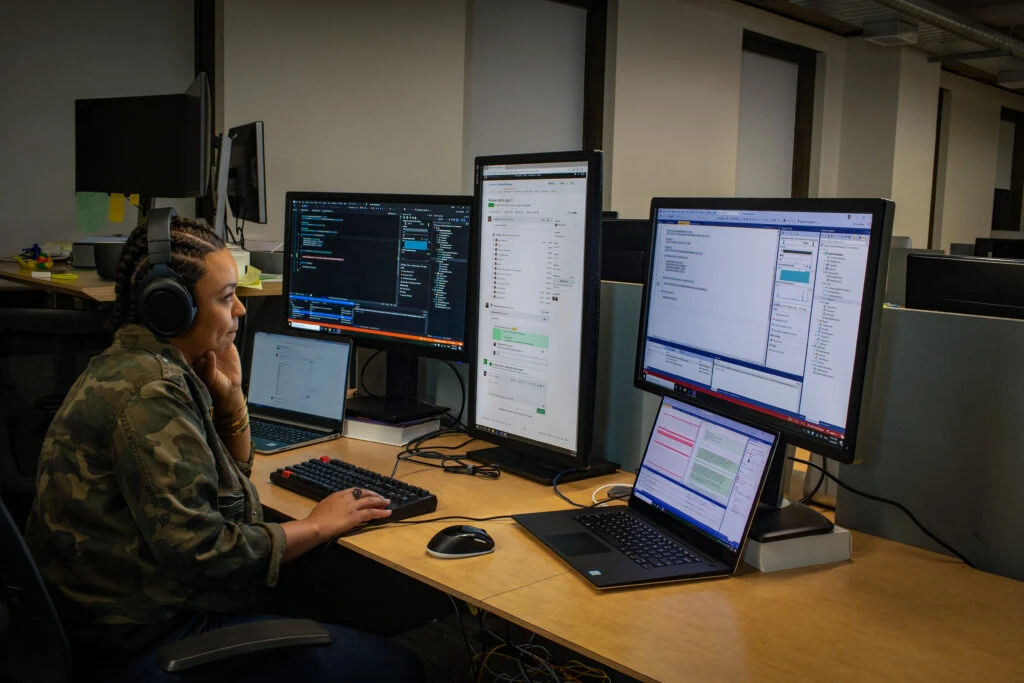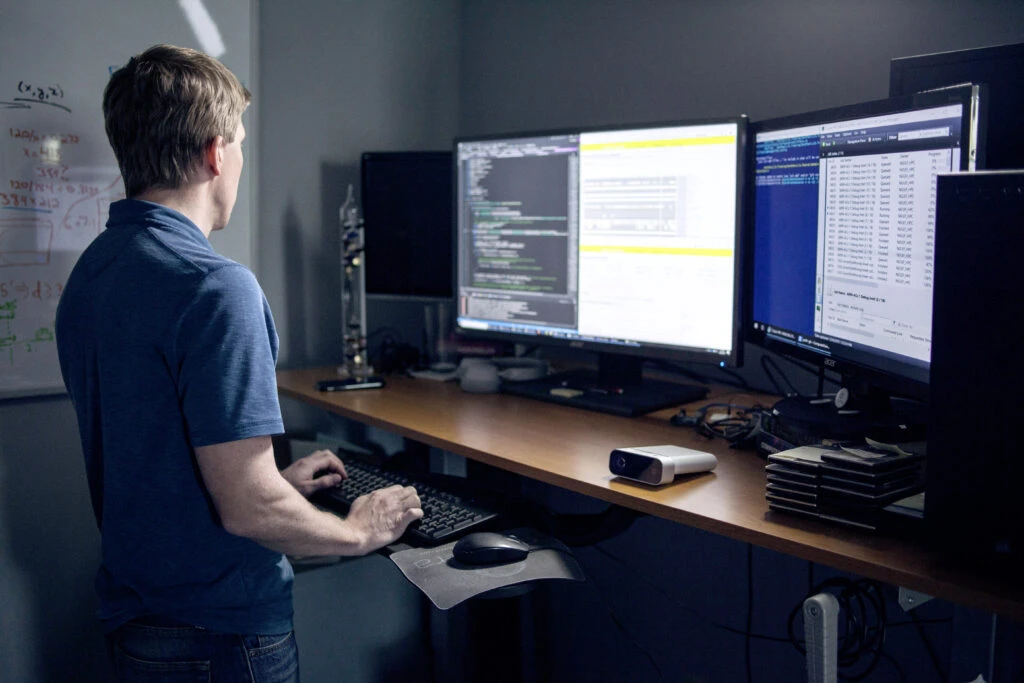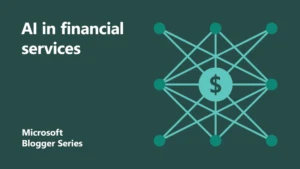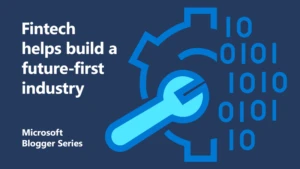
How to drive innovation and agility in financial services
I hear a lot of people talking about the journey to the cloud. But for me, the cloud isn’t a destination, it’s the enabler. The destination is agility.
When we talk about app innovation, we’re talking about exploring new ways to become more agile as organisations. I work with a lot of customers in the financial services industry and they all have one thing in common: they want to be more agile.
However being ‘more agile’ means different things to different financial service businesses depending on their starting point. Let’s break down the goal of app innovation into three horizons.
Modernising legacy systems to unlock and drive value

The first horizon is to have app innovation support legacy modernisation. “How can the cloud better optimise and enable the stuff we already run?” The focus is on efficiency: making things easier to manage, less onerous to upgrade, more sustainable. At the other end of the scale, the third horizon is all about the net new. How can app innovation empower us to bring new or better products to market? Or radically transform the way we bring products to market, expand our offerings to new markets, or bring new services online?
The shades of grey in between is the second horizon. The focus here is on things like transformation automation, or even simply moving applications ‘up the stack’. This means moving from manually managing Virtual Machines to leveraging Platform-as-a-Service (PaaS) offerings that can help streamline operations. Because innovation doesn’t have to be radical. Sometimes the most effective innovations are the incremental gains where we pay down some of the technical debt we’re carrying, slowly creating more agility, power, and momentum, ultimately allowing our teams to do more with less.
Here I want to unpack a few of these themes and shine a light on the great potential that app innovation in particular offers financial services organisations.
The value of business process automation
Technical debt is an analogy I often use to explain the challenge many financial services organisations face. Just like financial debt, the bigger the amount of technical debt you carry, the more interest you have to pay on it just to stand still.
But if I can pay down some of my technical debt, I can reinvest that interest in accelerating part of my organisation’s momentum in the right direction. For financial services organisations, this second horizon transformation can be extremely powerful.
Say you’re running an application that requires hundreds of virtual machines (VMs) to function. Somebody’s patching those VMs, manually making sure that the middleware on them is up and running. They ensure the connectivity, disaster recovery, the backup plans are all in place. Additionally, they build and maintain the data and applications that deliver business value and run them on those VMs.
If you can move some of that to a platform or service offering that manages that for you such as Azure, you can automate that process and reduce the manual labour. This is what we refer to as ‘moving up the stack’. Patching and updating becomes something you do with configuration. It may seem obvious to developers and development leads, but often the infrastructure status quo hampers the ability to see that bigger picture and build the business case for the move to PaaS. So it’s all about efficiency in the total cost to operate. How do you automate more of what you do, so you can move customers up the stack, free the teams that build these systems to spend less time manually overcoming hurdles and spend more time delivering business value?
Embrace an agile developer culture

A scenario that happens a lot in financial services is developer teams want to experiment with a new service. But they often spend more time filling out paperwork to request the infrastructure they need than it would actually take to do the development. However, by automating the secure creation and management of those environments, we can build agile dev teams.
Within policy controlled environments, we can create sandboxes where within minutes developers can experiment to see if the idea has legs and they want to scale, or if it’s not what they thought it was. Scale fast or fail fast, as they say.
Having the ability to be agile, to experiment, to test and learn, to play with new services quickly in an automated way, means you can genuinely innovate faster. And that is my goal: to unlock our customers’ ability to execute on their innovation and vision.
Develop a culture of innovation and change
When it comes to introducing new technologies, one of the pieces of the puzzle that is often overlooked is process. How do we create a culture of sharing best practise, encouraging reuse – a culture of inner sourcing? How do we encourage the collaboration environments in which developers can share the technology they build within their organisation? How do we promote reusability inside an organisation?
That’s where development collaboration platforms like GitHub become really powerful. It’s not just source control. It helps develop collaboration and empowers developers to reuse assets. You can do that by bringing the open-source approach into your own business and fostering that culture. It’s about saying: within my business, any business unit can take what I’ve built and reuse it or extend it or contribute back to it, but it’s not a public thing.
But a hurdle organisations need to overcome is feeling overwhelmed by the prospect of a cultural transformation. I often hear: “It’s such a big problem. I don’t know where to start. Huge cultural transformation. We’ll never get there.”
The key is to break the process down into bite sized chunks. Start with one key area of the business for one product, a set of workloads or a service line. Demonstrate the value of transformation in a smaller project. You’ll learn a load of lessons on the way about where the organisation is in its readiness to embrace that type of transformation. This may be politics, technology or real capabilities.
From there, you can grow. It typically takes a senior leader who believes in the project and wants to make it happen, as well as an engineering function that’s willing to embrace different ways of working and take onboard learnings from outside the business. But it also takes business units who want to be part of that process. If you’re a business unit and you want to just throw requirements over the fence and hope that somebody deals with them, that’s not going to work. That’s where the cultural change really needs to come together.
AI and innovation to drive customer expereinces

One of the main challenges facing the financial services industry at the moment is changing customer expectations. As consumers, we get instant gratification with the expectation for immediate delivery, instant access to data and service on-demand. As a result, we have that same expectation of our business interactions. We assume that every business should operate the same way. However in reality, the systems and processes in financial services aren’t geared for that.
At the same time, there is a challenge from FinTech start-ups nipping at the heels of established industry players. They don’t have the same technical debt to carry and are more agile. As a result, they can come at the industry from a very different angle, building services that feel much more like our consumer interactions, are much more data-led, where the experience is the same regardless of interaction – online, via apps, or an intermediary.
Both of these factors create a compelling need to be able to become a differentiator. To move faster, to innovate, to release new products, to meet the customer’s expectation. In the modern world of finance, we need that transformation to flow front to back, from the button I press on my phone through to that being recorded in a ledger somewhere. For insurance companies, it’s more about how we can use data and AI algorithms to calculate risk. If I can automate that process rather than it requiring human intervention, I can write more policies, I can take on more risk as an insurer, or win more business as a broker because I can make the decision much quicker.
These are the business outcomes. And in order to achieve them, we must be comfortable with building modern applications, and doing that rapidly, taking them to market quickly. Just like a FinTech start-up would.
But doing that means being agile, which we can’t be if we’re carrying lots of technical debt. We can’t do that if we’ve got lots of legacy to deal with. That’s where Microsoft can support our financial service partners. To reduce their technical debt. To modernise their processes and infrastructures. To unlock a future of agility, experimentation, and innovation.
Find out more
Imagine digital innovation that delivers a seamless experience with real impact
Drive business performance by empowering developers to innovate
Discover how to scale DevOps practices throughout your organisation
Resources to empower your developer team
Using Azure Pipelines to increase creativity and reduce costs
About the author

Matt heads up the Digital Transformation & App Innovation team within Microsoft UK’s Solutions business. He leads a team of innovation and development centred Specialists focused on helping customers understand, plan for, and adopt some of the most cutting-edge services in Microsoft’s arsenal – from GitHub for developer productivity, managed container offerings such as Azure Kubernetes Services, PaaS and serverless with Azure Functions and Logic Apps, Integration Services, Event Grid, and more, through to engaging wider stakeholder audiences in the development process through adoption of low-code development with Power Apps.
Matt’s background is firmly in engineering for innovation. With a master’s in computing and over two decades of experience from hands on ecommerce, payment and billing systems development in the late ‘90s and early 2000’s, to leading a global consulting team designing and rolling out bespoke Budgeting, Planning & Forecasting products for FTSE 10 integrated energy companies, and on to launching an IoT Pet Tracking start-up, founding, building, and selling a Digital Transformation consultancy before joining Microsoft in 2018.
Consistent to all of Matt’s endeavors is an understanding of what is possible, how it aligns to solving real world business challenges, and always starting with the “Why”.




